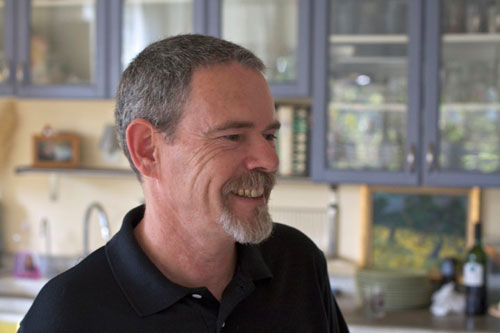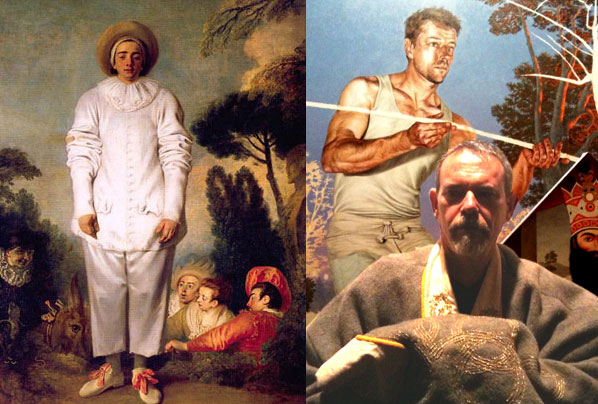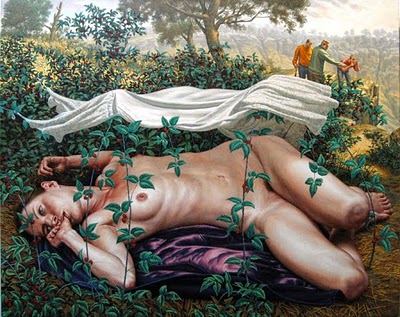F. Scott Hess, a painter whose works tend to magnify and reveal human frailties and failings, is a stable guy.
For the past 21 years he and his wife Gita have been living in Echo Park, just outside downtown Los Angeles, in a house that meanders up a steep hill. They have raised two daughters there, and when Scott hasn't been painting, he has been re-modeling and renovating a structure that came with plenty of flaws and quirks. The man who originally built the place, Scott tells me, had two main hobbies: construction and smoking marijuana.
As the structure's sober second owner, Scott has found that every time he peels off some drywall there are surprises, like supporting beams that were never nailed together. Bit by bit, he has located and repaired most of the problems, and the house now rests very securely above the Barrio meets Bohemia clamor of the neighborhood. Years of renovation - and years of paying down the mortgage - have resulted in a warm home that has grounded Scott's family and his in-laws, whose lives were turned upside down by the Iranian Revolution of 1979.

F. Scott Hess in his kitchen: a happy man
Photo by Jeff Doyle
The entry room, once a studio, is now a comfortable art-lined living room. A hallway leads up and back, past a book-lined study, to a dining area with windows that frame the view of a blooming fruit tree in a small courtyard. Over the years, the role of each room - and each level -- has been adjusted to create a kind of progression. The lower, front room is the welcoming public space, the dining room and kitchen are for entertaining friends and family, and the bedrooms are sequestered in the upper back section of the house.
As a recent dinner party was winding down, Scott mentioned to his guests that it was time to visit the studio, a small detached room at the top of the property. It took everyone about 60 seconds to stand up and trudge up the stairs for the visit. After all, when Scott Hess says "My private space is open to you," you know it won't be dull.
What a private space it is. The south wall is plastered with hundreds of art images, exhibition announcements and anything else that has gotten Scott's interest over the years. A host of oddities, some found, some manufactured, clutter the entry area. Part tree-house, part man-cave, part studio, part cabinet of curiosities, it is a place that feels very different than the house below.
There is no easel in the studio - there isn't much room for one - so Hess paints against the back wall. The first thing his guests saw when they entered was a striking work in progress: a painting of a man walking a tightrope. Tacked to the wall next to the image was a small poster of a Rococo painting, Watteau's "Gilles," which Scott later explained was source material for the tightrope walker. Although the man in the painting is roughly based on a neighbor, he is also something of a self-portrait. When I later asked Scott what the act of "balancing" stood for in the painting he replied:
"My sanity, my life, my reason for existence..."

"Gilles" by Antoine Watteau (left) provided the starting point for F. Scott Hess (foreground right) and his recent painting of a tightrope walker. In the photo Hess wears an oversized Confederate Army Uniform. Photo of F. Scott Hess by Marc Trujillo
Standing in his studio, facing his guests, Scott donned an over-sized felt Confederate Army jacket that is part of another ongoing project. Slated for exhibition at the Long Beach Museum of art in 2011, "The Paternal Suit: Heirlooms from the F. Scott Hess Family Foundation" will feature paintings, historical memorabilia and a host of other curiosities that Hess has been accumulating and inventing. Dealing with personal history, both real and invented, is another of Scott's balancing acts.
Hess has also been thinking hard about the way that family life shapes people. In his case the divorce of his parents when he was seven created a wound that art making has helped to address and heal. Thirty two years went by before he met his biological father again, and in the intervening years painting had provided the space where he speculated, fantasized and ranted about every aspect of what had happened, what might have happened, and what damage had and hadn't been done.
Once Scott had the jacket on his guests whipped out their iPhones and captured a very theatrical moment. In a coincidence that was both charming and un-nerving, he had become a kind of "Gilles" himself. In his studio, the Scott was a different man than the family guy who had baked lasagna for a dozen friends. The studio brings out his complex and vulnerable side.
This is the guy who has painted artists stealing Rembrandt paintings, women giving birth in the middle of nowhere, erotic disappointments, and girls watching looming fires. Come to think of it, the cast of characters in his oeuvre are the postmodern cousins of the Commedia dell Arte actors who surround the lonely figure of "Gilles." No wonder he feels the connection to Watteau.
Unlike many artists, Hess does not have a storage problem, as his works have consistently sold well over the years. Other than a few clunkers in his shed, his remaining paintings are with two dealers, Koplin Del Rio in Los Angeles, and Hirschl and Adler in New York. One major painting "The Colonel's Daughter" will be part of "Kink," a group show that opens in Los Angeles on June 5th. It used to hang on the wall of the artist's daughter Ava, who gave it up rather unhappily.

F. Scott Hess (b.1955)
The Colonel's Daughter, 2006
Oil on Canvas, 32 x 40 inches
Currently available at Koplin Del Rio Gallery, Los Angeles
"The Colonel's Daughter" deals with sex, a "complicated issue" that Hess has dealt with frankly for years. A reclining nude that updates the tradition established by Venetian artists 500 years ago, the woman in the picture puts men in an ambiguous situation. They are, in the artist's words "in the psychological position of either protector or rapist."
Hess feels that he couldn't paint a nude of this sort without an "edge" and in a sense this is a key to understanding what he does as an artist. During a 1993 trip to Iran, his art opened up and the "edge" sharpened, partly in response to having witnessed a society that was medieval in public, but obsessed with American porn and whiskey when the doors were locked. If the edge between your fears and fantasies isn't aired out, he realized, real madness will erupt. No wonder he practices the opening up of the private spaces in his home and in his life.
After the studio visit was over, Scott and his friends sat down for Persian cookies and conversation. Every now and then Scott takes out his digital cameras and snaps a few pictures, and I think a few people in the room were wondering if they might show up in his Commedia Dell Arte cast in the future.
If they do, they have nothing to worry about. F. Scott Hess may see the un-nailed joints in human behavior, but his goal is to fix them. He has done this for himself, and he may just do it for you too. As a younger artist his goal was to shock, but over the years he has become something of a handyman.
For the past 21 years he and his wife Gita have been living in Echo Park, just outside downtown Los Angeles, in a house that meanders up a steep hill. They have raised two daughters there, and when Scott hasn't been painting, he has been re-modeling and renovating a structure that came with plenty of flaws and quirks. The man who originally built the place, Scott tells me, had two main hobbies: construction and smoking marijuana.
As the structure's sober second owner, Scott has found that every time he peels off some drywall there are surprises, like supporting beams that were never nailed together. Bit by bit, he has located and repaired most of the problems, and the house now rests very securely above the Barrio meets Bohemia clamor of the neighborhood. Years of renovation - and years of paying down the mortgage - have resulted in a warm home that has grounded Scott's family and his in-laws, whose lives were turned upside down by the Iranian Revolution of 1979.

Photo by Jeff Doyle
The entry room, once a studio, is now a comfortable art-lined living room. A hallway leads up and back, past a book-lined study, to a dining area with windows that frame the view of a blooming fruit tree in a small courtyard. Over the years, the role of each room - and each level -- has been adjusted to create a kind of progression. The lower, front room is the welcoming public space, the dining room and kitchen are for entertaining friends and family, and the bedrooms are sequestered in the upper back section of the house.
As a recent dinner party was winding down, Scott mentioned to his guests that it was time to visit the studio, a small detached room at the top of the property. It took everyone about 60 seconds to stand up and trudge up the stairs for the visit. After all, when Scott Hess says "My private space is open to you," you know it won't be dull.
What a private space it is. The south wall is plastered with hundreds of art images, exhibition announcements and anything else that has gotten Scott's interest over the years. A host of oddities, some found, some manufactured, clutter the entry area. Part tree-house, part man-cave, part studio, part cabinet of curiosities, it is a place that feels very different than the house below.
There is no easel in the studio - there isn't much room for one - so Hess paints against the back wall. The first thing his guests saw when they entered was a striking work in progress: a painting of a man walking a tightrope. Tacked to the wall next to the image was a small poster of a Rococo painting, Watteau's "Gilles," which Scott later explained was source material for the tightrope walker. Although the man in the painting is roughly based on a neighbor, he is also something of a self-portrait. When I later asked Scott what the act of "balancing" stood for in the painting he replied:
"My sanity, my life, my reason for existence..."

"Gilles" by Antoine Watteau (left) provided the starting point for F. Scott Hess (foreground right) and his recent painting of a tightrope walker. In the photo Hess wears an oversized Confederate Army Uniform. Photo of F. Scott Hess by Marc Trujillo
Standing in his studio, facing his guests, Scott donned an over-sized felt Confederate Army jacket that is part of another ongoing project. Slated for exhibition at the Long Beach Museum of art in 2011, "The Paternal Suit: Heirlooms from the F. Scott Hess Family Foundation" will feature paintings, historical memorabilia and a host of other curiosities that Hess has been accumulating and inventing. Dealing with personal history, both real and invented, is another of Scott's balancing acts.
Hess has also been thinking hard about the way that family life shapes people. In his case the divorce of his parents when he was seven created a wound that art making has helped to address and heal. Thirty two years went by before he met his biological father again, and in the intervening years painting had provided the space where he speculated, fantasized and ranted about every aspect of what had happened, what might have happened, and what damage had and hadn't been done.
Once Scott had the jacket on his guests whipped out their iPhones and captured a very theatrical moment. In a coincidence that was both charming and un-nerving, he had become a kind of "Gilles" himself. In his studio, the Scott was a different man than the family guy who had baked lasagna for a dozen friends. The studio brings out his complex and vulnerable side.
This is the guy who has painted artists stealing Rembrandt paintings, women giving birth in the middle of nowhere, erotic disappointments, and girls watching looming fires. Come to think of it, the cast of characters in his oeuvre are the postmodern cousins of the Commedia dell Arte actors who surround the lonely figure of "Gilles." No wonder he feels the connection to Watteau.
Unlike many artists, Hess does not have a storage problem, as his works have consistently sold well over the years. Other than a few clunkers in his shed, his remaining paintings are with two dealers, Koplin Del Rio in Los Angeles, and Hirschl and Adler in New York. One major painting "The Colonel's Daughter" will be part of "Kink," a group show that opens in Los Angeles on June 5th. It used to hang on the wall of the artist's daughter Ava, who gave it up rather unhappily.

The Colonel's Daughter, 2006
Oil on Canvas, 32 x 40 inches
Currently available at Koplin Del Rio Gallery, Los Angeles
"The Colonel's Daughter" deals with sex, a "complicated issue" that Hess has dealt with frankly for years. A reclining nude that updates the tradition established by Venetian artists 500 years ago, the woman in the picture puts men in an ambiguous situation. They are, in the artist's words "in the psychological position of either protector or rapist."
Hess feels that he couldn't paint a nude of this sort without an "edge" and in a sense this is a key to understanding what he does as an artist. During a 1993 trip to Iran, his art opened up and the "edge" sharpened, partly in response to having witnessed a society that was medieval in public, but obsessed with American porn and whiskey when the doors were locked. If the edge between your fears and fantasies isn't aired out, he realized, real madness will erupt. No wonder he practices the opening up of the private spaces in his home and in his life.
After the studio visit was over, Scott and his friends sat down for Persian cookies and conversation. Every now and then Scott takes out his digital cameras and snaps a few pictures, and I think a few people in the room were wondering if they might show up in his Commedia Dell Arte cast in the future.
If they do, they have nothing to worry about. F. Scott Hess may see the un-nailed joints in human behavior, but his goal is to fix them. He has done this for himself, and he may just do it for you too. As a younger artist his goal was to shock, but over the years he has become something of a handyman.
